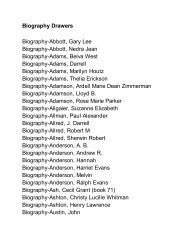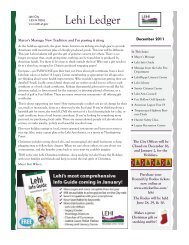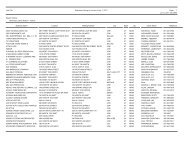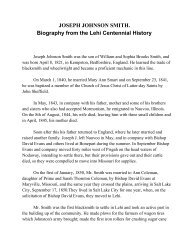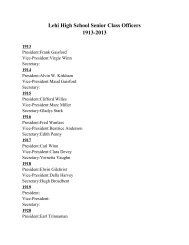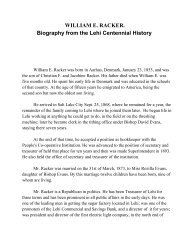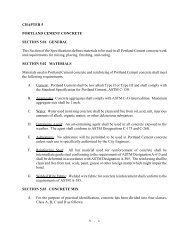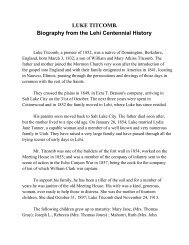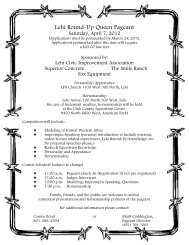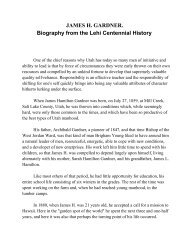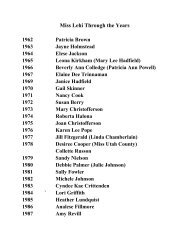Camp Williams Joint Land Use Study - Lehi City
Camp Williams Joint Land Use Study - Lehi City
Camp Williams Joint Land Use Study - Lehi City
Create successful ePaper yourself
Turn your PDF publications into a flip-book with our unique Google optimized e-Paper software.
October 2012
AcknowledgmentsA SPECIAL THANKSA special thanks to the participating communities that assisted in the development of the <strong>Camp</strong> <strong>Williams</strong> <strong>Joint</strong> <strong>Land</strong> <strong>Use</strong><strong>Study</strong> and Background Report. Bluffdale <strong>City</strong> Cedar Fort Town Eagle Mountain <strong>City</strong> Herriman <strong>City</strong> <strong>Lehi</strong> <strong>City</strong> Salt Lake County Saratoga Springs Utah CountyPOLICY COMMITTEEThe Policy Committee served an active and important role in providing policy direction during the development of the<strong>Camp</strong> W.G. <strong>Williams</strong> <strong>Joint</strong> <strong>Land</strong> <strong>Use</strong> <strong>Study</strong> (JLUS). The Policy Committee was comprised of the following individuals:Name Title EntityDerek Timothy Mayor Bluffdale <strong>City</strong>Mark Reid <strong>City</strong> Manager Bluffdale <strong>City</strong>LTC Tyler Smith LTC / Base Operations Manager <strong>Camp</strong> <strong>Williams</strong> (Alternate)Heather Jackson Mayor Eagle Mountain <strong>City</strong>Steve Mumford Planning Director Eagle Mountain <strong>City</strong> (Alternate)Coralee Moser Councilmember Herriman <strong>City</strong>Raquel DeLuca Former Councilmember Herriman <strong>City</strong>Gordon Haight Assistant <strong>City</strong> Manager Herriman <strong>City</strong> (Alternate)Bert Wilson Mayor <strong>Lehi</strong> <strong>City</strong>Doug Meldrum Econ. Dev. Director <strong>Lehi</strong> <strong>City</strong> (Alternate)Nicole Dunn Deputy Mayor Salt Lake CountyRolen Yoshinaga Planning Director Salt Lake CountyTravis Van Ekelenburg Urban Planner Salt Lake County (Alternate)Shellie Baertsch Councilmember <strong>City</strong> of Saratoga SpringsJim McNulty Planning Director <strong>City</strong> of Saratoga Springs (Alternate)COL Matt Price CFMO Director Utah Army National GuardGary Anderson County Commissioner Utah CountyBryce Armstrong Asst. Planning Director Utah County (Alternate)
AcknowledgmentsTECHNICAL COMMITTEEThe Technical Committee also served a key role in the development of the <strong>Camp</strong> W.G. <strong>Williams</strong> JLUS. They provided theoverall technical support, review and guidance of the study. The Technical Committee was comprised of the followingindividualsName Title EntityPaul Hill Board Member Alpine School District (ASD)James Bledsoe LTC Army AviationGrant Crowell Community Dev. Dir. Bluffdale <strong>City</strong>Nancy Lord Volunteer Bluffdale <strong>City</strong>Shawn Fullenbach MAJ/Project Officer <strong>Camp</strong> <strong>Williams</strong> (Alternate)Matt Branham LTC / Design and PM <strong>Camp</strong> <strong>Williams</strong>Tyler Smith LTC <strong>Camp</strong> <strong>Williams</strong>Chris Filoso MAJ/Base Operations Super <strong>Camp</strong> <strong>Williams</strong>Scot Olsen Representative Department of DefenseSteve Mumford Planning Director Eagle Mountain <strong>City</strong>Fionnuala Kofoed <strong>City</strong> Recorder Eagle Mountain <strong>City</strong>Ikani Taumoepeau Project Manager Eagle Mountain <strong>City</strong>Gordon Haight Assistant <strong>City</strong> Manager Herriman <strong>City</strong>Heather Upshaw Planner III Herriman <strong>City</strong>Luann Leavitt Representative Jordan School District (JSD)Kim Struthers Planning Director <strong>Lehi</strong> <strong>City</strong>Frankie Christofferson Planner II <strong>Lehi</strong> <strong>City</strong> (Alternate)Bob Allen Community Planner Mountainland Association of Governments (MAG)Travis Van Ekelenburg Urban Planner Salt Lake CountyAngelo Calacino Park Development PM Salt Lake CountyJim McNulty Planning Director <strong>City</strong> of Saratoga SpringsBryce Armstrong Asst. Planning Director Utah CountyLaura Ault Forest Legacy Coordinator Utah Department of Natural Resources (DNR)Shane Marshall Director-Region 3 Utah Department of Transportation (UDOT)Elise Erler Project Manager Utah School and Institutional Trust <strong>Land</strong>sAdministration (SITLA)Scott Festin Transportation Planner Wasatch Front Regional Council (WFRC)JLUS CONSULTANTCeleste Werner, AICPRichard Rust, AICPMichael HraplaMichele ParlettThis study was prepared under contract with Eagle Mountain <strong>City</strong>, with financial support from the Office of Economic Adjustment,Department of Defense. The content reflects the views of the key partners involved in the development of this study including Cities ofBluffdale, Eagle Mountain, Herriman, <strong>Lehi</strong>, and Saratoga Springs, the Counties of Salt Lake and Utah and <strong>Camp</strong> <strong>Williams</strong> and does notnecessarily reflect the views of the Office of Economic Adjustment.
AcronymsAAcq – AcquisitionACUB – Army Compatible <strong>Use</strong>BufferAE- Alternative EnergyAQ – Air QualityAPO – Agriculture ProtectionOverlay ZoneASD – Alpine School DistrictAT – Anti-Terrorism / ForceProtectionAT / FP – Anti-Terrorism / ForceProtectionATC – Aviation Troop CommandBBLM – Bureau of <strong>Land</strong>ManagementCCIP – Capital Improvement PlanCL – Competition for <strong>Land</strong> and AirSpaceComm – CommunicationCR – Cultural ResourcesDDisc – Real Estate DisclosureDNR – Division of NaturalResourcesDoD – Department of DefenseDPG – Dugway Proving GroundDS – Dust and SmokeFFAA – Federal AviationAdministrationFC – Frequency Spectrum CapacityFFSL – Utah Division of Forestry,Fire and State <strong>Land</strong>sFI – Frequency SpectrumInterferenceFY – fiscal yearHHA – Housing AvailabilityIHab – Habitat Management PlanI-15 – U.S. Interstate 15IC – IntergovernmentalCoordination/CommunicationIE – Infrastructure ExtensionsIED – Improvised Explosive DeviceICRMP – Integrated CulturalResources Management PlanINRMP – Integrated NaturalResource Management PlanIWFMP – Integrated WildfireManagement PlanJJLUS – <strong>Joint</strong> <strong>Land</strong> <strong>Use</strong> <strong>Study</strong>JSD – Jordan School DistrictLLeg – Legislative InitiativeLG – Light and GlareLI – Legislative InitiativesLU – <strong>Land</strong> <strong>Use</strong>MMAG – Mountainland Associationof GovernmentsMCA – Military Compatibility AreaMCAOD – Military CompatibilityArea Overlay DistrictMOU – Memorandum ofUnderstandingNNAAQS – National Ambient AirQuality StandardsNR – Scarce Natural ResourcesNVD – Night Vision DeviceOOEA – Office of EconomicAdjustmentPPlans – Plans and ProgramsPC – Policy CommitteePM-10 – Particulate matter 10micrometers in diameterPT – Public TrespassingRRC – Roadway CapacityREPI – Readiness EnvironmentalProtection InitiativeRMP – Resource Management PlanSSA – SafetySITLA – Utah School andInstitutional Trust <strong>Land</strong>sAdministrationSLCIA – Salt Lake <strong>City</strong> InternationalAirportTTC – Technical CommitteeTE – Threatened and EndangeredSpeciesUUDC – Utah Data CenterUDOT – Utah Department ofTransportationU.S. – United StatesUTARNG – Utah Army NationalGuardUTNG AGCW – Utah NationalGuard Army Garrison <strong>Camp</strong><strong>Williams</strong>USFWS – United States Fish andWildlife ServiceVVO – Vertical ObstructionsWWFRC – Wasatch Front RegionalCouncilWOD – Wildfire Overlay DistrictWS – Water Supply and QualityZZon – Zoning
Table of ContentsSections1. JLUS Project Overview ................................................................................................................................ 12. JLUS <strong>Study</strong> Area Profile .............................................................................................................................. 63. Assessment Methodology .......................................................................................................................... 74. Compatibility Assessment .......................................................................................................................... 95. Recommended Plan ................................................................................................................................... 13FiguresFigure 1. <strong>Camp</strong> <strong>Williams</strong> JLUS <strong>Study</strong> Area ................................................................................................................. 5Figure 2. Military Compatibility Area Overlay District (MCAOD)............................................................................. 14Figure 3. Impulse Noise MCA .................................................................................................................................... 15Figure 4. Light MCA ................................................................................................................................................... 16Figure 5. Aviation Safety MCA .................................................................................................................................. 17Figure 6. <strong>Land</strong> <strong>Use</strong> MCA ............................................................................................................................................ 18Figure 7. Sample Strategy Table ............................................................................................................................... 20TablesTable 1. High Priority Issues and Strategies ............................................................................................................ 21Table 2. Medium Priority Issues and Strategies ..................................................................................................... 31Table 3. Low Priority Issues and Strategies ............................................................................................................ 34Table 4. Awareness Issues and Strategies .............................................................................................................. 37
Table of ContentsA <strong>Joint</strong> <strong>Land</strong> <strong>Use</strong> <strong>Study</strong> (JLUS) is acollaborative planning process that balancesthe needs of communities and <strong>Camp</strong> <strong>Williams</strong>to promote compatible andsustainable growth.
1. JLUS Project OverviewOther Agency / Organization PartnersIn addition to the partners listed above, the<strong>Camp</strong> <strong>Williams</strong> JLUS partnered with other agencies andorganizations that provide a state, regional and / orcommunity perspective. These partners brought to thestudy a vast, expert knowledge base in varyingdisciplines, including state land use managementpractices, regional transportation practices, naturalresources and fire management, and a local“on-the-ground” perspective relevant to the unique landfeatures as well as land ownership patterns. A completelisting of the affiliated stakeholder groups that played avital role in the development of the <strong>Camp</strong> <strong>Williams</strong> JLUSfollows: Alpine School District Bureau of <strong>Land</strong> Management (BLM) Jordan School District Mountainland Association of Governments Utah Department of Natural Resources Utah Department of Transportation Utah Division of Forestry, Fire, and State <strong>Land</strong>s Utah Division of Water Resources Utah Schools and Institutional Trust <strong>Land</strong>sAdministration Wasatch Front Regional CouncilThese partners provided invaluable insights andperspectives to the development of the JLUS and theBackground Report.Public ParticipationThe general public was instrumental in the developmentof this JLUS and its strategies by providing theirperspective and feedback, both in the public forums andthrough the use of the interactive project website(www.campwilliamsjlus.com). During the developmentof the JLUS, three public workshops were held to solicitpublic input on the direction and content of the JLUS.JLUS CommitteesTwo committees, comprised of city, county, military, andother partner agencies and organizations, guided thedevelopment of the <strong>Camp</strong> <strong>Williams</strong> JLUS. Thesecommittees were: Policy Committee (PC). This committee wasresponsible for leading the direction of the JLUS; itsmembers are listed in the Acknowledgments sectionof this report.Technical Committee (TC). The TC identified andaddressed technical issues, provided feedback onreport development, and assisted in thedevelopment and evaluation of implementationstrategies. The TC members are listed in theAcknowledgments section of this report.Page 4 <strong>Camp</strong> <strong>Williams</strong> JLUS October 2012
2. JLUS <strong>Study</strong> Area ProfileP ROJECT S TUDY A REA<strong>Camp</strong> <strong>Williams</strong> is located in north central Utah, 26 milessouth of Salt Lake <strong>City</strong>, is situated to the west ofInterstate 15 (I-15) and straddles the boundaries of SaltLake and Utah Counties.Jurisdictions within the <strong>Study</strong> Area are the Cities ofBluffdale, Eagle Mountain, Herriman, <strong>Lehi</strong>, and SaratogaSprings, and the Counties of Salt Lake and Utah.The <strong>Camp</strong> <strong>Williams</strong> JLUS <strong>Study</strong> Area has been identifiedto address the surrounding lands proximate to <strong>Camp</strong><strong>Williams</strong> that may impact current or future militaryoperations or be impacted by those operations. The<strong>Camp</strong> <strong>Williams</strong> JLUS <strong>Study</strong> Area encompasses a 2.0- to3.5-mile area around the boundaries of the installation(depending on the direction) and encompassesapproximately 135 square miles (see Figure 1).Figure 1.<strong>Camp</strong> <strong>Williams</strong> <strong>Study</strong> AreaOctober 2012 <strong>Camp</strong> <strong>Williams</strong> JLUS Page 5
2. JLUS <strong>Study</strong> Area ProfileC AMP W ILLIAMS<strong>Camp</strong> <strong>Williams</strong> provides training facilities for the UtahArmy National Guard and Utah Air National Guard, U.S.Army and Army Reserve, U.S. Marine Corps and MarineCorps Reserve, U.S. Air Force and U.S. Air Force Reserve,and the Reserve Officers Training Corps. <strong>Camp</strong> <strong>Williams</strong>is also an important training site for local lawenforcement agencies and is frequently used by youthgroups. The UTARNG maintains 30 armories in 27communities within the State of Utah, and of these,<strong>Camp</strong> <strong>Williams</strong> is the main training site. With over 24,000acres, <strong>Camp</strong> <strong>Williams</strong> is one of the largest trainingfacilities for the National Guard in the western U.S.<strong>Camp</strong> <strong>Williams</strong> offers a wide variety of trainingenvironments to soldiers, airmen, and marines, such assmall arms training, artillery firing and maneuvering,basic airborne, demolitions training, land navigation, andhelicopter maneuvering. <strong>Camp</strong> <strong>Williams</strong> is considered apremier training facility because of the wide array oflive-fire and ground maneuvering training ranges itcontains and its similarity to the terrain in Afghanistan.In addition to the live-fire and demolition ranges,<strong>Camp</strong> <strong>Williams</strong> has numerous support facilities, such asadministration buildings, mess halls, classrooms, and acomplex of warehouses, workshops, and maintenancefacilities. <strong>Camp</strong> <strong>Williams</strong> has a billeting capacity of2,800 troops. <strong>Camp</strong> <strong>Williams</strong> provides facilities, logisticalsupport, and personnel help to military units training atthe installation. <strong>Camp</strong> William has the facilities that allowsoldiers to train in weapons live-fire familiarization andqualification, basic airborne and jump master refreshercourses, military academic courses (including fieldexercises), battalion-sized field training exercises, groupand brigade-sized command post exercises, urbanassault and defense training, mobilization processingexercises, artillery battalion live-fire exercises, individualtraining, and primary leadership development courses.Of the lands designated for training, <strong>Camp</strong> <strong>Williams</strong>’44 training areas encompass a total of 17,603 acres.The facilities at <strong>Camp</strong> <strong>Williams</strong> provide for wide-rangetraining at a single installation. Any training exercisesthat cannot be conducted at <strong>Camp</strong> <strong>Williams</strong> can bescheduled and completed at Dugway Proving Ground(DPG), which is located approximately 100 miles west ofthe <strong>Camp</strong>. Training occurs year-round, approximately50 weekends per year and 10 to 12 annual trainingperiods of up to 14 days each. The number of personnelwho train at <strong>Camp</strong> <strong>Williams</strong> can vary from year to year.L OCAL J URISDICTIONS IN S TUDY A REA<strong>Camp</strong> <strong>Williams</strong> is situated between two largemetropolitan areas, Salt Lake <strong>City</strong> and Provo, and islocated within two counties, Salt Lake County and UtahCounty. The cities immediately adjacent to <strong>Camp</strong><strong>Williams</strong> are Bluffdale, Eagle Mountain, Herriman, <strong>Lehi</strong>and Saratoga Springs. Even though the Town of CedarFort is not immediately adjacent to <strong>Camp</strong> <strong>Williams</strong> it iswithin the JLUS <strong>Study</strong> Area and its annexationboundaries touch the installation. The area surrounding<strong>Camp</strong> <strong>Williams</strong> has been rapidly growing in the recentpast. High growth rates are likely to continue due to thesupply of undeveloped or unincorporated land and theprovision of adequate public facilities and services.S TUDY A REA G ROWTH T RENDSBetween the Census conducted in 2000 and 2010, SaltLake County grew by 131,243 persons and Utah Countygrew by 148,028 persons. While similar in numbers, thegrowth in Utah County was substantially higher on anannual percentage basis due to its smaller totalpopulation in the year 2000. Salt Lake County grew byan annual rate of 1.4% over this time period while UtahCounty grew at an annual rate of 3.4%. Together, thesetwo counties represented a large percent of the totalgrowth throughout the state.Within Utah County, the biggest hubs of growth were inthe JLUS <strong>Study</strong> Area and the Provo area. The annualgrowth rates between 2000 to 2010 in the incorporatedcommunities was greatest in the Utah County cities ofEagle Mountain and Saratoga Springs, which saw annualgrowth rates of 25.8% and 33.3%, respectively. In SaltLake County, the greatest percent change in populationwas seen in Herriman, which had an annual growth rateof 30.5%.Page 6 <strong>Camp</strong> <strong>Williams</strong> JLUS October 2012
3. Assessment Methodology Potential Impact. Although an issue may notpresent a current threat to the installation or thecommunity, it may possess the ability to become anissue in the future. Should conditions change,adjacent or proximate development increase, orother issues become apparent, new conflicts withexisting or future missions and operational activitiesat <strong>Camp</strong> <strong>Williams</strong> could arise. Issues were consideredbased on their future potential using the samecriteria that were established for current impact.With a complete list of issues to be addressed in theJLUS, the public and TC were asked to identify therelative priority of each compatibility factor. Based onpublic and TC inputs on issues, the PC finalized theprioritization of the list of issues, dividing the factors intofour categories:High-Priority. Due to the nature of these issues, animmediate response is warranted. Issues identifiedas High Priority are to be addressed during the next1-2 years with a completion date of 2014. (2014).Evaluation of Existing ToolsIn order to develop a plan of action to addresscompatibility issues, it is important to fully understandthe tools already available that can be used. During thispart of the JLUS development, existing plans andprograms (tools) were reviewed for their applicability tothe issues identified. Based on this review, there werethree outcomes:1) Adequate Tool. The tool is appropriate as currentlyimplemented. This does not mean that the tool fullyaddresses an issue, but the tool is appropriate inhow it addresses the issue.2) Modify Existing Tool. If an existing tool can bemodified to better address compatibility, this ispreferable to the development of a completely newtool.3) Develop New Tool. In this case, the existing toolsare either inadequate or simply not designed toaddress the issue at hand.Medium-Priority. To be addressed 3-5 years aftercompletion of the JLUS (complete by 2017).Low-Priority. To be addressed within 10 years ofcompletion of the JLUS.Awareness Factors. Awareness factors are thoseissues that pose a minor threat to <strong>Camp</strong> <strong>Williams</strong>and/or the surrounding jurisdictions and aredocumented in this JLUS for the purpose ofmaintaining an operational awareness. These itemsdo not require action to address at the current time,but should be monitored long-term.Page 8 <strong>Camp</strong> <strong>Williams</strong> JLUS October 2012
4. Compatibility AssessmentC OMPATIBILITY F ACTORSThe previous section described the process used toidentify compatibility factors and assign priorities tothese factors. During this process, the committees andpublic also identified a range of individual issuestatements under each factor. For instance, under thecompatibility factor of “Infrastructure Extensions”, threeissue statements were identified/developed:1) Transportation Infrastructure Extensions, 2) ElectricalInfrastructure Extensions, and 3) Water InfrastructureExtensions.In the remainder of this section, each of the22 compatibility factors will be briefly described (bypriority), followed by a list of the issues identified underthat factor. More information on this analysis can befound in Section 3 of the <strong>Camp</strong> <strong>Williams</strong> JLUSBackground Report.High Priority IssuesInfrastructure Extensions represent compatibility issuesfor <strong>Camp</strong> <strong>Williams</strong> based on their proposed or plannedlocation. Transportation routes and electrical and waterinfrastructure impact land uses differently based onlocation, magnitude of the improvements, and theresulting outcome of the extensions. The result ofinfrastructure extensions tends to encourage andincrease development in the surrounding communities.This development can represent incompatibilities with<strong>Camp</strong> <strong>Williams</strong>’ military operations.Issues Transportation Infrastructure Extensions Electrical Infrastructure Extensions Water Infrastructure ExtensionsInteragency Coordination is the communication andcollaboration between multiple agencies engaged in acommon goal. For the <strong>Camp</strong> <strong>Williams</strong> JLUS, interagencycoordination represents several challenges for both<strong>Camp</strong> <strong>Williams</strong> and the surrounding communities. Thelack of interagency coordination in fire responsemanagement and planning activities to includeinfrastructure extensions and development can result inincompatibilities for the sustainment of the <strong>Camp</strong><strong>Williams</strong> mission and the growth of the surroundingcommunities.Issues Increased Coordination on Fire Managementand Response <strong>Land</strong> Ownership on <strong>Camp</strong> <strong>Williams</strong> Engage Military to Address Mutual Issues Noise Complaints<strong>Land</strong> <strong>Use</strong> is the impetus for the <strong>Camp</strong> <strong>Williams</strong> JLUS. TheJLUS assesses various components of land uses todetermine compatibility between unique militarymissions and the economic vision of the surroundingjurisdictions. This assessment is conducted to attainmutual goals and benefits to enable the military tocontinue to train its military personnel to achieve optimalreadiness, while still allowing for economic developmentin the adjacent communities. Certain land uses aresensitive to noise, vibration, and other outcomesgenerated by military training exercises. In contrast,certain land uses employed by communities can limitmilitary training activities.Issues Inappropriate Internal and External <strong>Land</strong> <strong>Use</strong>Designations Proximate Future Development ProjectsNoise and Vibration are the results of both militarytraining exercises as well as construction anddevelopment activities. These factors can present asincompatibilities with sensitive land uses. Noise that isloud and extends into the night hours can disrupt thelives of the public in adjacent communities. Also,vibration can disrupt daily living activities. This JLUSstrives to understand the needs of the communities toenable quality of life and continue to prepare and readymilitary personnel for years to come.Issues Demolition and Artillery Firing Grenade Off-BaseNoise and Vibration Military Helicopter Noise and Vibration Impacts Military Operations Noise and Vibration ImpactsPublic Trespassing is the unauthorized entry onto landsbelonging to other landowners. <strong>Camp</strong> <strong>Williams</strong> annuallyexperiences several instances of public trespassing dueto the lack of an adequate perimeter fence around theOctober 2012 <strong>Camp</strong> <strong>Williams</strong> JLUS Page 9
4. Compatibility Assessmententire installation, as well as the geography that occursin the area. The geography encourages hikers andnature enthusiasts to explore and experience the naturalworld. Trespassing on <strong>Camp</strong> <strong>Williams</strong> represents safetyconcerns for both the public and the military. Theinstallation conducts live-fire training exercises.Trespassing can pose a threat to human life and impedemilitary training due to unauthorized entry into the<strong>Camp</strong>.Issue An Inadequate Perimeter Boundary EncouragesTrespassingSafety issues are generated by both military and civilianland uses. Safety concerns relevant to militaryoperations include live-fire training exercises and theimpacts of those training activities, i.e., wildfires startedby live-fire. Safety issues are also evaluated based on theland uses that fall within the military training routesrelative to aircraft corridors and the accident potential.In addition, wildfires and trespassing can potentiallyrepresent a safety concern for the military.Issues Protection and Maintenance from Mission-Related Hazards High Potential for Urban Wildland FiresMedium Priority IssuesAnti-Terrorism / Force Protection (AT / FP) is theprotection and security of the nation’s defense andnational security. These issues exist when there is abreach of security in relation to the nation’s defense. Itis important for the UTARNG to address these issues toensure the military readiness for the State of Utah andthe country.Issue Intentional TrespassingDust and Smoke is another factor evaluated in this JLUS.Dust and smoke is a by-product generated by bothmilitary and civilian activities. Dust and smoke is not onlya nuisance relative to visibility, but it is also an issue forthe State of Utah as it relates to air quality in Salt Lakeand Utah Counties. Dust and Smoke was assessed in thisJLUS in the sense of the nuisance it creates for thegeneral public.Issue Dust and Smoke Generation by Military TrainingActivitiesRoadway Capacity can create incompatibilities betweenmilitary operations and civilian activities due to limitedavailability of roadway. Roadway Capacity in the <strong>Camp</strong><strong>Williams</strong> JLUS was evaluated on the basis of publicroadways meeting the needs of both military and civilianuses.Issues Military <strong>Use</strong> of Public Roadways Limited Mobility of Future Roadway NetworkVertical Obstructions are structures that impedenavigable airspace for both military and civilian aircraftoperations. Structures that pose a threat to the airspacefor military and civilian aviation include tall windmills andcell phone towers. It is important to ensure thecommunities adjacent to <strong>Camp</strong> <strong>Williams</strong> plan accordinglyto safeguard against unintended safety concerns relativeto structures that obstruct navigable airspace.Issues Potential for Military Aircraft Collisions with TallStructures Aviation CorridorsLow Priority IssuesCompetition for <strong>Land</strong> and Air Space is defined asmultiple uses of both land and air spaces. The<strong>Camp</strong> <strong>Williams</strong> JLUS evaluated the land and the air spaceuses between military and civilian activities. There areseveral civilian airports in the region that communicateand collaborate to use the airspace. In addition, themilitary must collaborate with regional airports as well asthe Federal Aviation Administration due to the restrictedairspace that exists over the <strong>Camp</strong> <strong>Williams</strong> installation.Issues Shared Military and Civilian Airspace General and Commercial Overflight RouteCompetitionPage 10 <strong>Camp</strong> <strong>Williams</strong> JLUS October 2012
4. Compatibility AssessmentFrequency Spectrum Capacity is the ability for themilitary to function and carry out missions based on theavailability of bandwidth. This factor presentsincompatibilities with the communities in the sense ofsimilar commercial operations using the samecommunications lines for transmitting operations. Forexample, the increased development of data centers incommunities tends to cause strain on local, availablebandwidth.Issue Specific Business and Employment Types CanAttract and Expand Utilization of BandwidthUtilized by the MilitaryFrequency Spectrum Impedance is the interruption ofelectronic signals due to the existence of a structure orobject between the source of the signal and itsdestination (receptor). The <strong>Camp</strong> <strong>Williams</strong> JLUSanalyzed the existing obstructions to determinecompatibility, as well as the likelihood of futureincompatibilities with these structures. Suchobstructions can include wind turbines and cell towers.There are two structures within the flight corridors thatrepresent potential incompatibilities with both militaryoperations and civilian communications.Issue Wideband <strong>Use</strong> and Vertical Obstructions CanRestrict or Degrade CommunicationsLight and Glare can be generated by both military andcivilian uses. Typically, light and glare issues representincompatibilities due to commercial lighting affectingnighttime military training — both on-the-ground and airtraining exercises. Military uses night vision devices totrain in realistic, combat environments. New commercialdevelopment can employ unshielded, or non-cutofflighting that produces ambient urban sky glow; this candegrade the effectiveness of night vision devices.Awareness IssuesAir Quality presents as an awareness issue for<strong>Camp</strong> <strong>Williams</strong> through the dust and smoke generatedby live-fire training exercises and / or a prescribed firesissue of debris and particulate matter air emissions.Conversely, wildland fires and development activities canalso emit air debris, causing the air quality to diminish inUtah.Salt Lake and Utah Counties are currently designated asa non-attainment area by the National Ambient AirQuality Standards (NAAQS). The man-made and naturalactivities that generate dust and smoke that contributeto air quality were assessed in the <strong>Camp</strong> <strong>Williams</strong> JLUS.Issue Non-Attainment Area Designation.Alternative Energy is the likelihood of development ofalternative energy conversion units within the<strong>Camp</strong> <strong>Williams</strong> JLUS <strong>Study</strong> Area. Alternative energyincludes wind and solar energy facilities in the <strong>Camp</strong><strong>Williams</strong> JLUS. Currently, there are two wind turbinefacilities in the study area. More specifically, they arelocated in the flight corridors, which can represent as avertical obstruction. The uncoordinated placement ofthese facilities can lead to incompatibilities with themilitary mission at <strong>Camp</strong> <strong>Williams</strong>.Issue Siting of Wind-to-Electricity TurbinesIssues Urban Development Generated Glare Improvised Explosive Device (IED) CourseGenerated GlareOctober 2012 <strong>Camp</strong> <strong>Williams</strong> JLUS Page 11
4. Compatibility AssessmentCultural Resources are those cultural and historicresources that require management and preservationunder the National Historic Preservation Act.<strong>Camp</strong> <strong>Williams</strong> hosts many cultural and historical sites onthe installation that require coordination and compliancewith state and federal laws.Issue Cultural Resources Management andPreservationHousing Availability is the availability of eligible andqualified housing units to the UTARNG. By law, theUTARNG permanent party is required to live off-post ineligible community housing provided by the localjurisdictions.Issue On-Base Housing Inventory for MilitaryPersonnel in Training and Transient PopulationLegislative Initiatives are those issues that requirelegislative action or amendments to ensure compatibilityfactors are addressed within the local jurisdictions. The<strong>Camp</strong> <strong>Williams</strong> JLUS process discovered that thejurisdictions do not possess the authority to incorporatemilitary compatibility guidelines and elements in theirgeneral and comprehensive plans.Issue Absence of State Legislation AddressingCompatible Planning Around MilitaryInstallationsScarce Natural Resources are the natural resources, suchas water, land, and air that must compete with bothmilitary operations and community development. Asdevelopment increases and / or changes, or expansionsin UTARNG missions occur, natural resources becomeincreasingly utilized and are not always considered inplanning.Issue Mining OperationsThreatened and Endangered Species constitutes a minorthreat for <strong>Camp</strong> <strong>Williams</strong> and the surroundingcommunities in this JLUS process. UTARNG complieswith the Endangered Species Act by mitigating impactsof various species, including the Bald Eagle. There is aknown golden eagle’s nest on the installation to whichtraining is off-limits. In addition, <strong>Camp</strong> <strong>Williams</strong> and theadjacent communities must collaborate in naturalevents, such as wildland fires, to ensure the survival ofspecies and their habitats.Issue Habitat ManagementWater Supply and Quality is the factor that assesses thequantity and quality of water resources in the <strong>Camp</strong><strong>Williams</strong> JLUS <strong>Study</strong> Area. This factor evaluates theamount of water that is utilized by the installationrelative to the available supply of water and thencompares that with the demand and supply that isutilized by the surrounding jurisdictions to provide forthe necessary public services. In addition to evaluatingthe water supply, this factor also reviews the overallquality of public water uses in the JLUS <strong>Study</strong> Area.Water Quality can be affected by military operations,public recreation use, and stormwater drainage.Issue Stormwater Retention/DrainagePage 12 <strong>Camp</strong> <strong>Williams</strong> JLUS October 2012
5. Recommended PlanI MPLEMENTATION P LANThis section identifies and organizes the recommendedcourses of action (strategies) that have been developedthrough a collaborative effort between representativesof applicable local jurisdictions, the UTARNG, state andfederal agencies, local organizations, the general publicand other stakeholders that own or manage land orresources in the region. Because the <strong>Camp</strong> <strong>Williams</strong>JLUS is the result of a collaborative planning process, therecommendations in this section represent a trueconsensus plan; a realistic and coordinated approach tocompatibility planning developed with the support ofstakeholders involved throughout the process.JLUS strategies incorporate a variety of actions that canbe taken to promote compatible land use and resourceplanning. Upon implementation, existing and potentialcompatibility issues arising from the civilian / militaryinterface can be removed or significantly mitigated. Assuch, the recommended strategies function as the heartof the JLUS document and are the culmination of theplanning process.It is important to note that the JLUS is notan adopted plan, but rather a recommendedset of strategies which should be implementedby the JLUS participants in order to addresscurrent and potential future compatibilityissues.The key to the implementation of the strategiespresented in this JLUS is the establishment of the JLUSCoordinating Committee that oversees the execution ofthe JLUS. Through this Committee, local jurisdictions,<strong>Camp</strong> <strong>Williams</strong>, and other interested parties will be ableto continue their initial work together to establishprocedures, recommend or refine specific actions formember agencies, and make adjustments to strategiesover time to ensure the JLUS continues to resolve keycompatibility issues through realistic strategies andimplementation.Implementation Plan GuidelinesThe key to a successful plan is balancing the differentneeds of all involved stakeholders. In working towards abalanced plan, several guidelines became the basis uponwhich the strategies were developed. These guidelinesincluded: In concert with the Utah state laws, theImplementation Plan was developed with theunderstanding that the recommended strategiesmust not result in a taking of property value. In somecases, the recommended strategies can only beimplemented with new enabling legislation.In order to minimize regulation, where appropriate,strategies were recommended only for specificgeographic areas to resolve the compatibility issue.Similar to other planning processes that includenumerous stakeholders, the challenge is to create asolution or strategy that meets the needs of allparties. In lieu of eliminating strategies that do nothave 100% buy-in by all stakeholders, it wasdetermined that the solution / strategy may result inthe creation of multiple strategies that address thesame issue but would be tailored to individualagencies.Compatibility AreasIn compatibility planning, the generic term “MilitaryCompatibility Area” (MCA) is the term used to formallydesignate a geographic area where military operationsmay impact local communities, and conversely, wherelocal activities may affect the military’s ability to carryout its mission. The MCAs are geographic areas wherethe majority of the recommended strategies apply. Theproposed <strong>Camp</strong> <strong>Williams</strong> Military Compatibility AreaOverlay District (MCAOD) is an area that incorporates allsubzones.The MCAOD and MCAs are used to define the geographicareas where the JLUS strategies are to be applied. Thistechnique ensures the strategies are applied to theappropriate areas, and that locations deemed to not besubject to a specific compatibility issue are not adverselyimpacted by regulations that are not appropriate fortheir location or circumstance.Page 13 <strong>Camp</strong> <strong>Williams</strong> JLUS October 2012
5. Recommended PlanFigure 2.Military Compatibility Area Overlay District (MCAOD)<strong>Camp</strong> <strong>Williams</strong> Military Compatibility AreaOverlay DistrictAn MCAOD is proposed as the zoning tool used forimplementing the policies and regulations associatedwith each <strong>Camp</strong> <strong>Williams</strong> MCA. The MCAOD is designedto reflect the area comprised of all the MCAs combined(see Figure 2).<strong>Camp</strong> <strong>Williams</strong> Military Compatibility AreasAn MCA is a formally designated geographic planningarea where military operations may impact localcommunities and conversely, where local activities mayaffect the military’s ability to carry out its mission. AnMCA is designated to accomplish the following purposes:1) Promote an orderly transition between communityand military land uses so that land uses remaincompatible.2) Protect public health, safety, and welfare.3) Maintain operational capabilities of militaryinstallations and areas.4) Promote an awareness of the size and scope ofmilitary training areas to protect areas separate fromthe actual military installation (i.e., critical air space)used for training purposes.5) Establish compatibility requirements within thedesignated area, such as requirements for soundattenuation, real estate disclosure, and avigationeasements.An MCA delineates a geographical area where strategiesare recommended to support compatibility planning andthe JLUS goal and objectives.Page 14 <strong>Camp</strong> <strong>Williams</strong> JLUS October 2012
5. Recommended PlanTo better reflect the area of interest and focusimplementation, several MCAs are further divided intosubareas.The four MCAs used in the <strong>Camp</strong> <strong>Williams</strong> JLUSImplementation Plan are listed below, and shown anddescribed on the following pages.1) Impulse Noise MCA2) Light MCA3) Aviation Safety MCA4) <strong>Land</strong> <strong>Use</strong> MCAImpulse Noise MCAThe Impulse Noise MCA includes all lands locatedoff-installation that fall within the 60-65 dB DNL noisecontour for live-fire ranges (see Section 3 of theBackground Report for details). Residentialdevelopments and other sensitive land uses within thisMCA may be subject to sound attenuation measures toreduce noise impacts. Figure 3 illustrates this MCA.Figure 3.Impulse Noise MCAOctober 2012 <strong>Camp</strong> <strong>Williams</strong> JLUS Page 15
5. Recommended PlanLight MCAThe Light MCA addresses areas that may generatelighting levels that may affect night training missions andoperations at <strong>Camp</strong> <strong>Williams</strong> (see Figure 4). As describedin Section 3 of the Background Report, there are twotypes of light pollution that can impact militaryoperations: point source lighting, which directly impactsNight Vision Device (NVD) use and training, and ambientlighting or background lighting, where the cumulativeeffect of light pollution diminishes the capability of NVDsand NVD training. Light intensity decreases withdistance, therefore, the more distance between the lightsource and the military installation, the greater thereduction of light pollution impacts.LIGHT MCA SUBZONEThis subzone represents a buffer of less than one-halfmile from the perimeter of the installation (see Figure 4).New development that falls within this MCA may besubject to lighting regulations that include fully-shieldedand / or full-cutoff light fixtures. Additional strategiesalso include the development of a retrofit program forexisting lighting fixtures. For the technical backgroundinformation, see Chapter 3 of the Background Report.Figure 4.Light MCAPage 16 <strong>Camp</strong> <strong>Williams</strong> JLUS October 2012
5. Recommended PlanAviation Safety MCASafety associated with rotary-wing flight operations is amajor concern to both the military and the communitiessurrounding <strong>Camp</strong> <strong>Williams</strong>. The Aviation Safety MCAdefines an area of increased concern as an area that isone-half mile on each side of the rotary-wing flightcorridors (see Figure 5).The strategies associated with the Aviation Safety MCAare related to land use planning as it considers accidentpotential from rotary-wing aircraft, as well as verticalobstructions such as wind turbines and cell towers andtheir potential impacts on flight safety.Figure 5.Aviation Safety MCAOctober 2012 <strong>Camp</strong> <strong>Williams</strong> JLUS Page 17
5. Recommended Plan<strong>Land</strong> <strong>Use</strong> MCAThis MCA encompasses the land area within one mile ofthe boundary of <strong>Camp</strong> <strong>Williams</strong>. The land use MCAconsists of two subzone areas (see Figure 6) designed toprovide a transitional area relative to land use densityand intensity transitioning from a less dense area nearerthe installation to a denser area further from theinstallation boundary.Strategies attached to this MCA are related to land useplanning and disclosure requirements (as a part of realestate transactions).<strong>Land</strong> <strong>Use</strong> MCA Subzone AThe <strong>Land</strong> <strong>Use</strong> MCA Subzone A represents ½ mile areaaround the perimeter of <strong>Camp</strong> <strong>Williams</strong>. This area shallbe characterized by lower density / intensitydevelopment to consider the military training operationsthat occur on <strong>Camp</strong> <strong>Williams</strong>. Strategies for this arearecommend a development density of one dwelling unitper acre, but no more than two dwelling units per acre.Intensities in this area shall not be more than 0.25 in floorarea ratio.<strong>Land</strong> <strong>Use</strong> MCA Subzone BThe <strong>Land</strong> <strong>Use</strong> MCA Subzone B represents the area ½ mileto one mile from the installation boundary. This subzonearea is designed to be a transitional area where higherdensities / intensities than allowed in Subzone A may beconsidered. Allowable densities would be one to sixdwelling units per acre except where the Aviation SafetyMCA overlays the <strong>Land</strong> <strong>Use</strong> MCA subzone. Where thisoccurs, the recommended density is one to two dwellingunits per acre.Figure 6.<strong>Land</strong> <strong>Use</strong> MCAPage 18 <strong>Camp</strong> <strong>Williams</strong> JLUS October 2012
5. Recommended PlanHow to Read the Implementation PlanThe strategies developed were designed to address theissues identified during preparation of the JLUS. Thepurpose of each strategy is to:1) Avoid future actions, operations, or approvals thatwould cause a compatibility issue,2) Eliminate an existing compatibility issue,3) Reduce the adversity of an existing issue, or4) Provide for on-going communications andcollaboration.To make the strategies easier to use, they are presentedin a table format that provides the strategy andinformation on when and how that strategy will beimplemented. Figure 7 highlights the format andcontent of the strategy table, and the followingparagraphs provide an overview of how to read theinformation presented for each strategy in the JLUS.Issue # – The issue # is an alpha-numeric number thatprovides a unique reference for each specific issue andstrategy.Type of Strategy. This column identifies the type ofstrategy being recommended. The column contains oneof the following acronyms to represent the tool type: Acq – Acquisition CIP – Capital Improvement Program Comm – Communication and Coordination Disc – Real Estate Disclosures Hab – Habitat Conservation Tools Leg – Legislative Tools MOA – Memorandum of Agreement MOU – Memorandum of Understanding MCA – Military Compatibility Area Plans – Comprehensive / General / Master /Hazard / Airport Plans Zon – Zoning Ordinance / SubdivisionRegulationsMilitary Compatibility Area (MCA) – This columnindicates the applicable MCA, if the strategy relates to anarea outside <strong>Camp</strong> <strong>Williams</strong>. Please see the heading“Compatibility Areas” for more details.Strategy – In bold type is a title that describes thestrategy. This is followed by the complete strategystatement that describes the action needed.Timeframe – This column indicates the projectedtimeframe of each strategy. The timeframes aredescribed below:2014 Strategy to be completed by 2014 (within 1-2years of JLUS completion)2017 Strategy to be completed by 2017 (3 to 5years from JLUS completion)On-goingAn on-going implementation actionResponsible Party – At the right end of the strategy tableare a set of columns, one for each jurisdiction, militaryentity, agency, and organization with responsibilitiesrelevant to implementation of the <strong>Camp</strong> <strong>Williams</strong> JLUSstrategies. If an entity has responsibility relative toimplementing a strategy, a mark is shown under theirname. This mark is one of two symbols that representtheir role. A solid square () designates that the entityidentified is responsible for implementing the strategy.A hollow square () designates that the entity plays akey supporting role, but is not directly responsible forimplementation.The responsible parties are identified by their assignedacronym in the heading at the top of each page.BLMDNRFFSLMAGSITLAUDOTUTARNGUFAWFRCBureau of <strong>Land</strong> ManagementUtah Department of Natural ResourcesUtah Division of Forestry, Fire and State<strong>Land</strong>sMountainland Association of GovernmentsUtah Schools and State Institutional Trust<strong>Land</strong>s AdministrationUtah Department of TransportationUtah Army National Guard, the agency thatprovides oversight and administers thebudget to all National Guard units in theState of Utah.Unified Fire AuthorityWasatch Front Regional CouncilOctober 2012 <strong>Camp</strong> <strong>Williams</strong> JLUS Page 19



